Role of Pastors
Plank Chapel Cemetery
A HISTORY OF PLANK CHAPEL UNITED
METHODIST CHURCH
The
history of Plank Chapel United Methodist Church came down to us largely
by tradition. There were no official church records kept locally
concerning the founding and early history of the church, but a research
by several members in the late 1940's and early 1950's have disclosed a
number of relatively reliable facts.
The
people who were living in what is now known as the Bobbitt or Plank
Chapel community following the Revolutionary War - 1776 - had heard of
the Methodist movement which was being spread in America but had
originated in England.
At a Baltimore Conference in 1776 the Carolina Circuit was formed.
Among itinerants of early Methodism coming to North Carolina was one
named John King. Some local young men became preachers. The first one
about whom we have record was John Young, who was influenced to become
a Methodist by Mr. King. Mr. Young was a native Virginian, reared near
Hampton, but moved to North Carolina in 1775, and lived a while in
Halifax County. Later he located in the Bobbitt area which was known as
Hayesville and was a part of Franklin County. Bishop Asbury ordained
Mr. John Young as a Deacon on December 12, 1792. This paper has been
preserved by the Young family.
In the summer of 1780 Bishop Asbury visited this section. On July 10,
1780 he records: "Made my journey to Roger Jones', about sixty people.
God was with us." Dating from this visit of Bishop Asbury to Roger
Jones', the history of Plank Chapel can be traced.
Roger Jones owned and lived in the home place which was in later
years the home of his descendants, Mrs. Pamelia Jane Gill Allen
(wife of Demarcus S Allen), better known as "Aunt Melia" to Plank
Chapel. She was the mother of Mr. J. Bayard Allen and Nettie
Allen Deans. It was in a large room of this house, which stood on what
is now known as the 400 block of Gilburg Road, that the Methodist
Society was formed in the summer of 1780. The meetings were held here
in Roger Jones' home until a Methodist Meeting House was built on a
part of his plantation. (Sadly, the house was destroyed.) He (Roger
Jones) was the original founder of Plank Chapel and though not a
preacher himself was the means, under God, of Methodism being
introduced into the community. His descendants are many and are members
of Plank Chapel today.
The first building was made of hand-hewn logs and called "The Methodist
Meeting House." The date of this building has not been established.
About 1800 this Meeting House was replaced by a building of hand sawed
planks and timbers, and put together with wooden pegs and handmade
nails. It was a novelty for a building to be built of anything other
than logs, thus the new building was named Plank Chapel. This was built
on the southern end of Mr. John W. Young's plantation. Mr. Young was
minister for many years and affectionately called "Old Father Young" in
his later years.
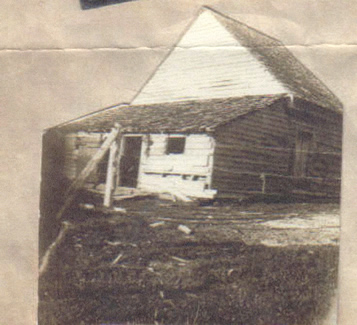
Planks from the first Plank Chapel Circa 1800
A
deed found in Franklin County Register of Deeds dated December 9, 1809;
states that Roger Jones conveyed to William Jones, William Arendell,
Goodman Smith, Daniel Edwards, James Hunt and George King as Trustees.
Containing the house now known by the name of Plank Chapel and supposed
to contain one acre of land be the same, more or less, together with
all the houses, woods, waterways and benefits. This document further
states, "this is to be used as a house of worship for the members of
the Methodist Episcopal Church, according to the rules and Discipline
of the General Conference." The sum of 5 shillings was paid for this
tract of land.
The
second deed was written in 1836. Thomas Powell sold to John Young as
chairman for the sum of $2.00 for two acres of land located on the
Westside of the then Plank Chapel land of one acre. This deed was not
recorded until September 29, 1869 when it was presented to the probate
courts and proved under oath by H.H. Hight. Jordan Denson and J.H.
House who were witnesses were dead as was Thomas Powell and John Young.
The court accepted the presented names of the Board of Trustees. The
Board of Trustees were: A.T. Fuller, J.W. Young, R.P. Gary, J.T. Hunt,
R.P. Overton, T.L.D. Smith and D.D. Overton. The deed was accepted by
the court and ordered recorded. This deed is recorded in Franklin
County.
In
1858 this church became inadequate and was replaced by another Chapel
built of plank. It was built under contract with Mr. William L. Peace
for the sum of $635.00. Both of these were built on the present site of
Plank Chapel United Methodist Church.
A
Sunday school program, as we know it today, was formed at Plank Chapel
in 1872 by Dr. William Clark. He also became the first superintendent
of Plank Chapel. In the years 1875 to 1878 Reverend Richard Webb was
pastor; he was called the "Missionary Preacher." Taking a special
interest in children he gave them cotton seeds in the spring to plant,
tend and harvest; then the children would give their
profits to missions.
During
the last decade of the eighteenth century a great revival of religion
swept over America, and Camp Meetings came into being. Plank Chapel was
a meeting ground.
The following description of
those Camp Meetings is quoted from Miss Nettie Allen s' writings:
"Marvelous are the tales our grandmothers have told of Camp Meeting
days … how the year's events dated to or from that great event; of how
the crowds that would attend, whole families, young and old, saint and
sinner, coming for the days and weeks of service, living in cabin or
tent, of the wonderful sermons by the visiting preachers."
Several
young men of the community were named in papers of Miss Nettie Allen as
"Class Leaders" or preachers during the 1800's including the Civil War
period. (Messrs. Thompson Fuller, Lorenzo Dow Smith, Moses J. Hunt, and
Medicus Hight.) Mr. Hunt and Mr. Hight were sent from this church to be
itinerant preachers.
In 1899-1900, under the
pastorate of Reverend B. C. Allred, more space was needed. At this time
another building was erected; this was the first building with a
steeple and is the same structure which is the current sanctuary. It
was built by James A. Harris, who was responsible to some extent for
design of the structure, father of Bessie Harris Rowland, and the great
grandfather of Patricia Fuller and James Rowland.
The first event held in the new church, which was not yet quite
finished, was the wedding of Celestia Jones Gill and Issac Jones Young,
II on January 1, 1900. The church did not have a roof or a finished
floor. This did not bother the bride or the groom.
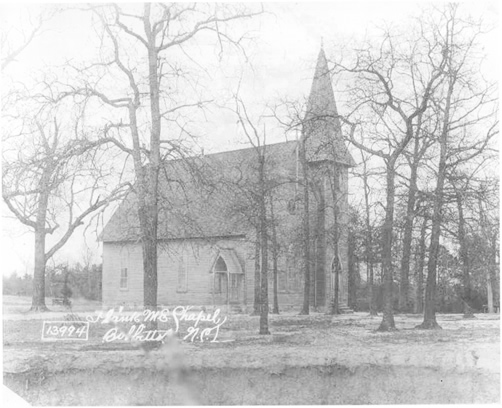
Circa 1900
The
third deed to the church was written April 20, 1904 and recorded in
Vance County Register of Deeds on May 17, 1904. This deed established
the boundaries for the church and added one and one-quarter acres to
the two acres previously held by the church. The Trustees were: Joseph
S. Hunt, Robert J. Gill, John W. Kittrell and Patrick A. Bobbitt. Those
agreeing to the boundaries and adjacent owners were: D.H. Gill and wife
Pattie J. Gill, P.A. Bobbitt and wife Geneva E. Bobbitt and H.M. Hight
and wife S. Florence Hight. The church now had a total of four and
one-quarter acres of land.
In
1910 the Women's Missionary Society was re-organized. The Sally Lou
McKinnon group was organized for the young people and the Olive Allen
Bright Jewel Band for the children. Although the men did not have a
formal organization they were named honorary members of the Ladies
Society and assisted in many functions.
Through
the years the name of the Women's Missionary Society has changed names.
Now it is The United Methodist Women, but the purpose has always
remained basically the same. The women of Plank Chapel have always been
mission-minded, as records will show, in addition to all of the many
things they have done for the church and community.
Probably
the most meaningful and memorable event ever to take place at Plank
Chapel was the Homecoming of 1924 when the pageant written by Mrs.
Celestia Gill Young and Mrs. Clara Evelyn Gill Wilkins, both of whom
were descendants of Roger Jones, was presented. The pageant told the
history of the church including the scenes of Bishop Asbury's first
visit to Roger Jones' home, the legendary Camp Meetings, and the
beginning of Sunday School. About seventy-five members took part in
this presentation which taught history and brought back treasured
memories. It has been said that there were more people gathered on that
Homecoming Day of Plank Chapel than ever before or since.
In
addition to the pageant, seven rooms were added in 1924. These rooms
were used for Sunday School rooms. Reverend J.C. Williams was pastor
during this time. There have been several other changes and additions
made to the church since the Sunday School rooms. The floors were
refinished in 1938, and in 1943 new pews were added. Stained glass
memorial windows were installed in 1944, and a new electric lighting
system and a heating system in 1948. In 1955 the church bought a new
electric Hammond organ. During the pastorate of Reverend N.P. Edens,
1947-1951, the choir was reorganized and for the first time choir robes
were used.
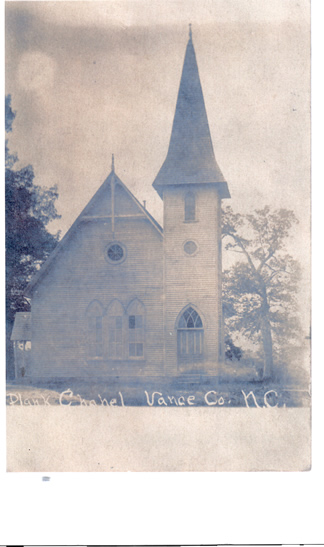 Circa 1924
Circa 1924
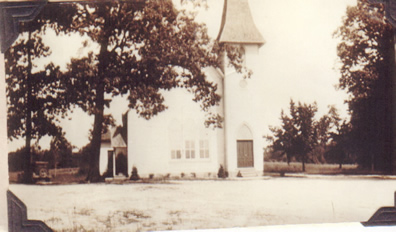 Circa 1930
Circa 1930
In
1957 the Methodist Men's Club was organized. Through the years they
have sponsored many projects to supply needs of the church. In 1959
they sponsored a barbecue and with the profits new carpet was installed
in the church. In later years this dinner/supper would serve as many as
1,700 plates. Profits from these suppers have been used for projects in
the church and mission projects both near and far.
The
altar was remodeled in 1959 by Mr. and Mrs. T.C. Gill. The wooden
furniture on the pulpit was given by Mrs. T.C. Gill. In 1959 the
original altar rail was refinished by Mr. Walton Smith and funds were
given by Mr. and Mrs. Donald Mitchell. The marble baptismal font was
given by Edward and Lula Thurmond.
During the
pastorate of Reverend Robert Rudd on August 13, 1961 the parsonage
ground-breaking ceremony was held. Mr. and Mrs. Ira W. Finch gave the
land for the new parsonage. This was the first major building project
staged by the church since the Old Tar River Circuit was divided. On
November 13, 1961 the parsonage was completed and Reverend Robert Rudd
and his family moved in. The parsonage is located on Kittrell Road.
The first well at Plank Chapel was dug, March 24, 1963. Prior to this time, the water was furnished by neighbors.
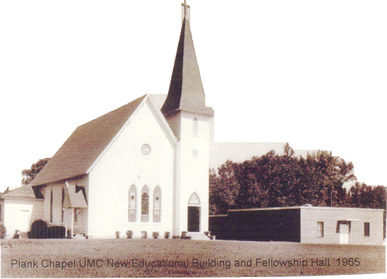
The cross on top of the steeple was made of copper from a still.
This cross was installed in the 1950's.
In
1965 another big step was taken. The classrooms were no longer large
enough to accommodate the members. The need for an Educational Building
was realized by the congregation. Plans were formalized and the
building was started in January of 1965 and completed in December of
1965. The new building would have a Fellowship Hall with a kitchen and
six classrooms.
On
July 7, 1968 the building was paid for and was dedicated. Reverend
Gordon Allen was pastor at this time. Reverend Robert Rudd and Reverend
N. P. Edens, past ministers, were present for this July 7th occasion.
In September 1968 new red Methodist Hymnals were bought and added joy to the worship in song.
The first central air conditioning system was installed in the church and Educational Building in 1969.
In 1973 aluminum siding was installed on the church and a breezeway
joined the church to the Education Building. In 1974 the church was
newly wired and new light fixtures were given for the Sanctuary. Also
in 1974, an outdoor bulletin board was built and given as a memorial to
Donald Mitchell.
In
1974 the interior of the church was painted, the choir loft was
installed and the folding doors were removed to make added space in the
sanctuary. Memorial pews and carpet were installed in the new area.
In 1975 chimes were installed above the organ. The chimes were given by
Mr. and Mrs. Julian Smith, Mr. and Mrs. Jack Hunt and Mr. and Mrs. John
Rogers. This addition has added much pleasure to the congregation and
the community.
The outside chimes, Maas-Rowe Carillons, were given in memory of
members of the Harris, Rowland and Finch family by family and friends.
Prior to 1975, Kittrell UMC and Plank Chapel UMC was a charge and
shared a preacher. In 1975 Kittrell was disbanded and Plank Chapel, for
the first time, had a full time preacher. Many of the members of
Kittrell transferred their membership to Plank Chapel.
In 1980 we celebrated the 200th Anniversary of our church with many
members, former members, visitors, and church dignitaries present.
In the late 1980's the handbells were given by Mr. and Mrs. John Rogers.
In 1988 a new heating system was installed in the pastor's study.
A Senior Citizens Circle was organized in 1989 by Reverend Mike Weber.
This program has become very popular. Membership is open to any one
over the age of 50. Several churches are represented in its attendance.
The sanctuary was painted in May of 1989.
During the summer of 1990 repairs to the threshold and a complete new
coat of shingles was applied to the church complex. Of great interest
to many of the men in the community, a crane was used to reach the
steeple to remove the copper cross and shingles and replace them with
no difficulty.
Also in 1997 pew Bibles were given in honor or memory of members and
friends. This has assisted the attendees in following the scripture
being read.
In June of 1994 the stained glass windows were given a protective
coating to ensure the safety of the glass. It was reported the company
that made the windows had gone out of business and it would be
difficult to replace them.
September 6, 1996 Hurricane Fran visited the area and brought much
rain. This caused flooding to the furnace room, as a result, repairs
were made to the foundation in this area and a new furnace was
installed. These repairs should insure that flooding does not happen
again in this area.
In 1998 a new sound system was given in memory of Mr. and Mrs. Willie Kittrell and Mr. and Mrs. Egbert Kittrell.
In 1999 a mission team from Plank Chapel went to Costa Rica. This
mission team was from the Durham District which included Mr. and Mrs.
Joe Sears and Mr. and Mrs. James Deans and was lead by Reverend William
Budzinski.
On December 15, 2002 new blue choir robes were dedicated. These robes were given in memory of Mrs. Mamie G. Mitchell.
December 22, 2002 the first copy of the new Church Directory was
presented to Mrs. Mary Allen Rowland Finch. She was honored as having
the longest continued membership in Plank Chapel. Mrs. Finch joined the
church in August of 1923. She recently retired from the choir.
During the winter and spring of 2003-2004, the Methodist Men had new
carpet and tile installed in the Fellowship Hall, including the
classrooms.
In 2003 a new sound system was installed in the Sanctuary in memory of Ruth R. Newman.
A ground breaking ceremony took place for the addition of a bedroom and
bath, as well as, renovations to the parsonage February 29, 2004. The
project was completed March 2005 at the cost of about $50,000.00.
On
May 16, 2004 a Memorial Garden was dedicated in memory of Mrs. Nell
Williams, wife of Reverend Jimmy Williams, a former pastor given by her
family and dedicated by the church. This garden is located between the
Church and the Fellowship Hall.
During the fall and
winter of 2004-2005, the Methodist Men have been aggressive in cleaning
the old cemetery located on the east side of the church. This is very
much appreciated by the church, as well as, the community.
In 2005 original doors at the front and side entrances of the church
were restored. This restoration was a gift from the Donald Mitchell
family.
Entering into the future with new innovations, the Summer of 2005
brings Plank Chapel to the Web. With the support of the NC Methodist
Conference and help from Robin Bumpass the Website can be found at
www.plankchapel.org. Plank Chapel is the first church to host a site
under the NC Methodist Conference's new domain hosting ministry.
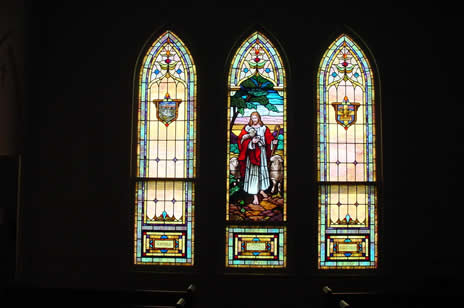
Windows given in memory of Father Young (1747-1837)
Pastor and Donor of Site
Presented by Great Grand-Children
Back to Homepage
Back to Top



 Circa 1924
Circa 1924  Circa 1930
Circa 1930
